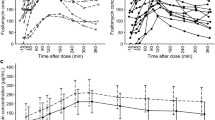Abstract
WHEN a drug is given by intravenous infusion it is not possible to define its lethal dose if it is detoxified rapidly, because the apparent lethal dose will depend on the rate of administration of the drug. This difficulty has been emphasized by Beccari1, who pointed out that in the case of drugs which are rapidly eliminated it is better to define a ‘lethal rate’ of infusion rather than a lethal dose. The problem of deciding at which rate of infusion to determine the lethal dose has always been apparent in the study of cardiac glycosides, and has been accentuated by the earlier need for biological assay of these drugs. The relationship between rate of infusion and lethal dose of cardiac glycosides and aglycones is complex, depending both on the individual drugs and the species used for the determination of toxicity. In the British Pharmacopœia (1958) and the U.S. Pharmacopœia (thirteenth revision) this problem is defined by laying down maximum and minimum times during which each determination of lethal dose must be made. From Table 1 it can be seen that the apparent lethal dose of digoxigenin determined in the guinea pig depends on the time taken to produce death. At the lower rates of infusion in which the time to produce death is prolonged, the apparent lethal dose has the highest values.
This is a preview of subscription content, access via your institution
Access options
Subscribe to this journal
Receive 51 print issues and online access
$199.00 per year
only $3.90 per issue
Buy this article
- Purchase on Springer Link
- Instant access to full article PDF
Prices may be subject to local taxes which are calculated during checkout
Similar content being viewed by others
References
Beccari, E., Arch. intern. Pharmacodyn., 73, 65 (1946).
Hatcher, R. A., Arch. int. Med., 10, 268 (1912); J. Amer. Med. Assoc., 61, 386 (1913).
Hauptstein, P., Arch. Exp. Path. Pharmak., 126, 121 (1927).
Rand, M., and Stafford, A., Nature, 177, 278 (1956).
Author information
Authors and Affiliations
Rights and permissions
About this article
Cite this article
RAND, M., STAFFORD, A. Effect of the Rate of Elimination of Digoxigenin in the Guinea Pig on the Determination of its Lethal Dose. Nature 183, 688–689 (1959). https://doi.org/10.1038/183688a0
Issue Date:
DOI: https://doi.org/10.1038/183688a0
Comments
By submitting a comment you agree to abide by our Terms and Community Guidelines. If you find something abusive or that does not comply with our terms or guidelines please flag it as inappropriate.



